Schrade SCHKM1 Large Kukri Machete Reviewed
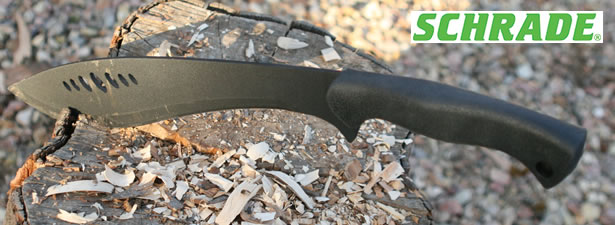
Marketing from Schrade
The Schrade Large Full Tang Kukri Machete Fixed Blade, Black Powder Coated 3Cr13 Stainless Steel Blade, Safe-T-Grip Handle with Lanyard Hole, Nylon Shoulder/Belt Sheath with Removable Storage Pouch — NEW from: http://schrade.com
Bursting with well conceived design elements, the SCHKM1 is becoming a Kukri Machete of choice among serious outdoor enthusiasts. With an overall length of nearly twenty inches, the machete’s blade shape and balance characteristics deliver powerful cutting and chopping blows. The black powder coated 13.3″ blade comes straight out of the box with paper shaving sharpness. Forged from hard, strong 3Cr13 stainless steel the blade is well suited for impact cutting, holding an edge and easy to resharpen, its thick spine and contour taking deep bites with every stroke.
The machete’s full tang extends through a Safe-T-Grip handle, the palm swelling ergonomic design textured for excellent hand-gripping traction under all-weather conditions. The handle widens and flares at the butt, supporting proper hand placement when delivering sweeping power strokes. A lanyard hole provides a tethering option for added security.
The SCHKM1’s well thought out design continues throughout its nylon form fitting sheath whose twin snaps tightly secure the machete while affording quick access. Carry options abound letting you choose from either belt… leg… or shoulder. The adjustable padded shoulder strap detaches via swivel connectors. Adjustable leg straps are equipped with quick-release snaps. A detachable pouch on the sheath’s face comes holding a ferro rod and striker together with a diamond field sharpener.
An excellent machete for tactical and survival applications… crafted from premium materials… and built for a lifetime… This is the SCHKM1 Large Kukri Machete.
Manufacturer: Schrade, www.schrade.com
Model: SCHKM1
Overall Length: 19.7″ (50.0 cm)
Blade Steel: Black Powder Coated 3Cr13 Stainless Steel
Blade Length: 13.3″ (33.8 cm)
Handle Material: Safe-T-Grip
Handle Length: 6.4″ (16.2 cm)
Weight: 1.44 lbs
Accessories: Nylon Shoulder/Belt Sheath w/ Storage Pouch, Field Sharpener, Fire Striker
Warranty: Limited Lifetime Warranty against any manufacturing defects
MSRP: $56.00
UPC: 044356220545
The Review
When you are researching survival options, most look to products that can perform in a multitude of situations. Single-purpose products simply won’t cut it, and bladed tools are no different. So basically we need to find a tool that can perform basic bushwhacking and bushcraft tasks under any survival situation and eliminate the need to carry a separate hatchet, knife and machete. Today, we’ll be looking to see how Schrade’s full-tang, large Kukri Machete stands up to the challenge…
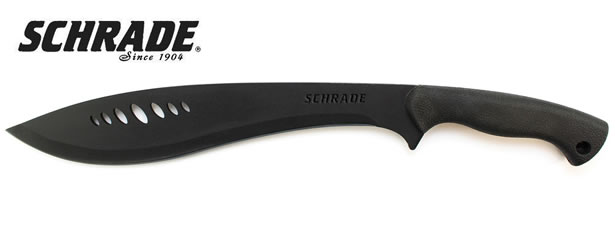
Initial Thoughts
When I first opened the box, I was initially impressed with the large ballistic nylon shoulder/belt sheath and carrying strap. I was happy to see the sheath was of a similar quality to many of Schrade’s other nylon sheaths. Surely there are better out there, but Schrade’s are typically not too shabby either. The Field Sharpener and Fire Striker packed in the removable storage pouch is a nice touch as well.
With a large 13.3″ full-tang Kukri-shaped blade, Schrade’s SCHKM1 was constructed with 4mm-thick powder-coated 3Cr13 stainless steel providing plenty of strength and reliability in a well-balanced recurved pattern. I also want to commend Schrade for providing yet another blade-product sharp right out of the box.
The ergonomic Safe-T-Grip handle is a hard rubberized plastic similar to Schrade’s TPE handles, providing an extremely durable and secure grip, even under wet conditions. The handle also includes a lanyard hole perfect for a paracord tether.
As a sub-$35 machete constructed entirely from high-quality materials that is well-balanced and comfortable to wield, throw in the nylon sheath and goodies, this blade is looking like a real winner. Now lets get into the nitty-gritty.
Features
Now lets focus on the SCHKM1’s features in more detail…
The Blade
Schrade’s SCHKM1 is a 4mm thick fine-edged machete with an overall length of 19.7″, a blade length of 13.3″ and a total weight of 21.4 ounces. The SCHKM1 is made from a single piece of 3Cr13 Stainless Steel running throughout. Its full-tang design provides the superior strength and rigidity that you would expect from any good survival blade.

3Cr13 stainless steel is similar in quality, strength, hardness, corrosion resistance and edge retention to 420B stainless steels. Stainless steel is a popular class of material for knife blades because it has properties that are commonly resistant to rust and corrosion, while remaining easy to maintain. This makes it an excellent choice for a survival blade. This alloy is typically easier to sharpen than other stainless alloys like 440C and holds an edge quite well.
While the 3Cr13 stainless steel and full-tang blade design are certainly durable enough to withstand a moderate amount of punishment, it is only rust resistant, and not rust proof. Even with the protective powder-coating, it is still susceptible to rust without proper care and maintenance. If the blade becomes wet, simply dry it thoroughly and lightly coat it with an oil like Break-Free CLP before storage. If you do, it just might last you a lifetime.
Schrade’s Kukri machete has an attractive hollow-ground drop-point edge with a large recurve and narrow-pointed tip was modeled after the Nepalese knife with an inwardly curved (or recurved) edge. Similar to a machete, a Kukri blade is used as both a tool and a weapon in Nepal and neighbouring South Asian countries.
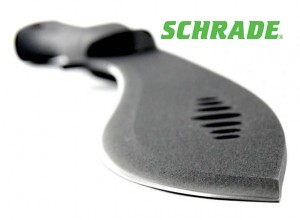 A drop-point profile is best described as a blade with a convex curve that extends from the spine to the tip providing a strong, robust blade that is easy to direct when chopping, cutting and prying, but is often less suitable for piercing. The shape of this blade provides a bit more leverage perfect for heavy bushwhacking tasks like chopping and lighter bushcraft techniques like carving and shaving sticks.
A drop-point profile is best described as a blade with a convex curve that extends from the spine to the tip providing a strong, robust blade that is easy to direct when chopping, cutting and prying, but is often less suitable for piercing. The shape of this blade provides a bit more leverage perfect for heavy bushwhacking tasks like chopping and lighter bushcraft techniques like carving and shaving sticks.
Many blade types including the drop point, clip point, and even a hawkbill can have a recurve. A recurve is best described as a blade characteristic or feature rather than a blade shape. A recurve generally refers to a blade with a sweeping “S” shaped edge which are often used to help balance a large chopping blade as well as changing the blade’s angle in an attempt to improve its slicing, chopping and draw-cut capabilities. Unfortunately, it can be somewhat challenging to sharpen with a stone due to the inward curve (or recurve) at the base of the drop-point.
The Smith’s PP1 Pocket Pal Multifunction Sharpener or Lansky PS-MED01 BladeMedic are perfect for providing a quick edge when in the field. However, they tend to leave striations down the length of the blade which are likely to cause it to dull much faster, as opposed to perpendicular striations that are left by most stone sharpening methods. Therefore, the provided field sharpener will likely provide better results.
The SCHKM1 provides a large choil between the blade and the handle. A choil is simply the un-sharpened part of a blade where the blade becomes part of the handle. Sometimes there is an indention shaped to accept the index finger.
Jimping is a term used when describing the small notches cut into the back of a blade or put on the choil or other areas of a knife to prevent your fingers from sliding when using the knife. The SCHKM1 does not contain any jimping whatsoever so fine-control while using the choil may be challenging.
The SCHKM1 also works perfectly when striking a ferro rod, with or without the protective coating.
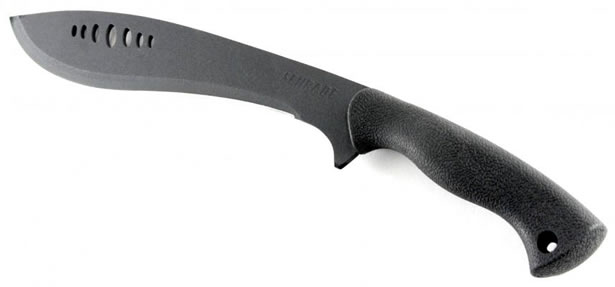
The Handle
The SCHKM1 provides an extremely durable Safe-T-Grip handle ergonomically shaped with a large palm-swell to provide ample leverage, balance and grip as you wield the Kukri blade, even under the wettest of conditions.
The Safe-T-Grip handle is a hard rubberized plastic similar to Schrade’s TPE handles, best described as a highly durable colored high friction surface treatment consisting of a thermosetting epoxy dressed with pigmented or natural high-friction aggregates.
The handle also includes a lanyard hole perfect for a paracord tether.
The Sheath
Schrade provided a large ballistic nylon shoulder/belt sheath with the SCHKM1. The sheath includes an over-the-shoulder carrying strap in addition to two leg straps and a belt loop. Although the sheath is single-stitched, it is riveted for durability.
Packed in the removable storage pouch is a field sharpener and Ferro rod. I haven’t had the opportunity to try out the field sharpener yet, but the Ferro rod is an excellent size and quality. It will provide an ample amount of heat and spark with each strike to get a fire going quickly.
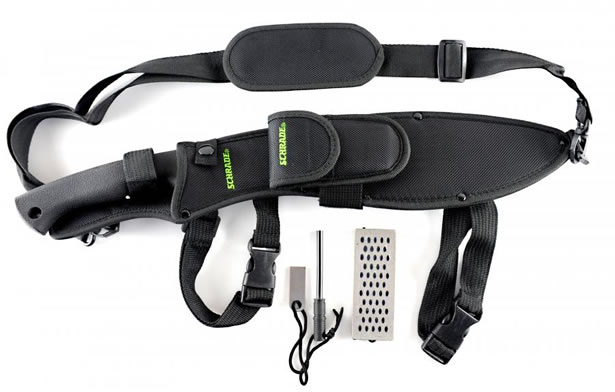
Functional Testing
Now lets see how the SCHKM1 performs… In order to provide a some sort of apples-to-apples comparison between blades, I will be performing five durability tests; Batoning, Chopping, Feather Stick, Tip Strength and Edge Retention. In a survival situation, all resources are fair game. However, since I am not in a life-or-death situation, I’ll stick to some seasoned wood that I have lying around for these tests.
Batoning
Per Wikipedia: Batoning is the technique of cutting or splitting wood by using a baton-sized stick or mallet to repeatedly strike the spine of a sturdy knife, chisel or blade in order to drive it through wood. The batoning method can be used to make kindling or desired forms such as boards, slats or notches. The practice is most useful for obtaining dry wood from the inside of logs for the purpose of fire making.
To test the SCHKM1’s ability to be used with a baton, I found a stick around 2″ in diameter by about 18″ long for my baton and a few logs around 4″ in diameter and about 12″ long to hack into kindling. I placed the first log on its end and began to whack both sides of the SCHKM1 evenly with the baton. It went through the entire log with very little effort.
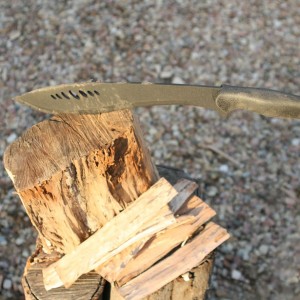 I repeated the test a few more times by splitting the log into smaller and smaller pieces, and then again a few more times with similarly-sized material. Some fresh logs and others that have been drying out for a couple of seasons. The SCHKM1 and baton performed very well, even with all of the knots that I ran into. I was thoroughly impressed.
I repeated the test a few more times by splitting the log into smaller and smaller pieces, and then again a few more times with similarly-sized material. Some fresh logs and others that have been drying out for a couple of seasons. The SCHKM1 and baton performed very well, even with all of the knots that I ran into. I was thoroughly impressed.
At this point, I thought it would be a good time to try the SCHKM1 and the baton on some heavier material. I began sectioning off some kindling from a larger stump about 12″ in diameter. This is typically done by splitting off 1-2″ slices from the outer-edge of the stump, parallel to the ring-line. I worked my way around the stump, slowly moving inward until the remaining section was small enough to quarter.
SCHKM1’s thick 4mm blade and long-flat spine provide a stout surface to strike with the baton without risk of bending the blade or damaging the spine. The SCHKM1 performed just as well as any knife that I’ve batoned with.
Chopping
Next, I decided try my hand at chopping some long branches into a manageable size which would be necessary for building a shelter or creating a stockpile of firewood to get through the night. At almost 1-1/2 pounds, the SCHKM1’s weight provides an ample amount of striking force. By gripping the SCHKM1 at the flared end of the handle with your thumb and fore and middle fingers, you can extend the radius of your swing providing even more force when chopping. Even with the Safe-T-Grip handle, if you do need to swing the blade for any length of time, I thoroughly recommend wearing gloves to protect your hands and absorb some of the shock.
The SCHKM1 made quick work of smaller branches 1-2″ in size and didn’t struggle with the larger 3-4″ material either. While the SCHKM1 would likely perform well on larger material and it could certainly get the job done in a pinch, a hatchet or small axe are much better suited.
Feather Stick
Per Wikipedia: A feather stick (sometimes referred to as a fuzz stick) is a length of wood which is shaved to produce a head of thin curls protruding from the wood. It is used for damp wood to start a fire (or campfire) when dry tinder is hard to find.
For the next test, I thought making a feather stick would be in order.
For this test, I used a stick about 1-1/2″ in diameter and a little shy of 18″ long. First, I removed the outer back from the lower 8″ of the stick. I found the SCHKM1 worked best by setting it deep into a stump at an 45° angle so my leg could support the handle. Then I proceeded to shave 2-3″ curls otherwise known as “feathers” all the way around the stick, starting at the bottom-end then slowly working my way up.
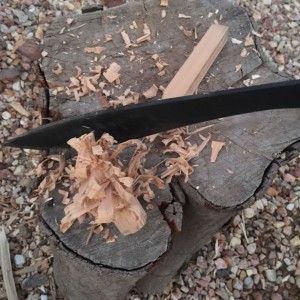 As I continued my way around the stick, I was careful not to shave the curls too long or dig too deep causing them to break off. However, I was using a hard wood so it was not as easy as it could have been with a softer material. I found that the recurve area just behind the recurve of the blade to be the sweet-spot for feathering the stick.
As I continued my way around the stick, I was careful not to shave the curls too long or dig too deep causing them to break off. However, I was using a hard wood so it was not as easy as it could have been with a softer material. I found that the recurve area just behind the recurve of the blade to be the sweet-spot for feathering the stick.
About 6″ up, I began to work my way around deeper and deeper into the stick until I was almost all the way through. Then I snapped the feathered section off leaving what can only be described as a 6″ tall pinecone. I had a finely-feathered stick to start a fire.
All in all, the SCHKM1 performed very well… I fact, much better than I had expected it to at this task. Its extra-long stature and fixed position made it much easier to control and maneuver the material.
Tip Strength
To test the SCHKM1’s ability to stab or pierce without the tip bending or breaking, I simply drove the tip of the blade into the end of a 12″ stump as hard as I could. Then I loosened the blade using a side-to-side motion until it was loose enough to pull out. I repeated this action a few more times without any sign of damage.
Next, I used the SCHKM1 to bore a cone-shaped hole into the side of a small log approximately 1″ in diameter and about 3/4″ deep by twisting the blade until the hole was completed. The SCHKM1 performed this task without any tip damage.
Edge Retention
Even after all of the other functional tests, the SCHKM1 easily sliced through a single sheet of paper without issue. My testing left no sign of cracks, chips or imperfections of any kind with the exception of some slight wear on the blade’s protective coating. The SCHKM1 held its edge and remained very sharp through the entire process, even with all of the punishment that I threw at it.
Final Thoughts
Schrade’s Kukri machete has certainly been a rugged performer. The SCHKM1 was designed to be tough, and built to last. Ideal for most survival situations, especially clearing light brush. The SCHKM1 does not provide as much fine-control as a small survival knife, nor can it provide as much force and cutting-power as a survival axe, so it may not be considered as the ultimate replacement for any of those survival tasks. Each are inherently better at doing what they were specifically designed for. However, if this was all you had available to you, you could feel confident that the SCHKM1 would not let you down.
The SCHKM1 can be found most anywhere on the Internet for right around $35. Truly an impressive survival machete worthy of including in any camp gear or bug-out bag. I am glad I have mine.
You can find this and other Schrade products here: http://amzn.to/2c0kjZF
![]()
About Taylor Brands and Schrade Cutlery
 Founded by Stewart Taylor in 1975, Taylor Brands has been manufacturing, designing, and distributing high-quality stainless steel cutting tools and accessories since our inception. Taylor Brands owns and produces Schrade, Old Timer, Uncle Henry, and Imperial branded products, and are also licensed to produce multiple product lines under the world famous Smith & Wesson brand. In total Taylor Brands manufactures several hundred different products including fixed and folding knives, collapsible batons, tactical pens, handcuffs, tactical and survival accessories, and flashlights.
Founded by Stewart Taylor in 1975, Taylor Brands has been manufacturing, designing, and distributing high-quality stainless steel cutting tools and accessories since our inception. Taylor Brands owns and produces Schrade, Old Timer, Uncle Henry, and Imperial branded products, and are also licensed to produce multiple product lines under the world famous Smith & Wesson brand. In total Taylor Brands manufactures several hundred different products including fixed and folding knives, collapsible batons, tactical pens, handcuffs, tactical and survival accessories, and flashlights.
--